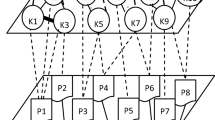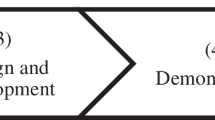Abstract
Conventional approaches for identifying domain experts focus only on their level of expertise and fail to consider their innovation potential. Thus, we propose a more comprehensive method by considering the types of innovation tasks and their corresponding knowledge domains. With a set of novel and effective metrics, the proposed method is able to assess the knowledge quality and innovation potential of each participating user. We evaluate our method with a real-world dataset collected from a popular online innovation community. The results indicate that the proposed method is efficient and scalable for contributory domain expert identification with different innovation tasks and different knowledge domains. This work expands expert identification research by providing both a new theoretical angle and new technical solution for quantifying the value of users.









Similar content being viewed by others
Explore related subjects
Discover the latest articles and news from researchers in related subjects, suggested using machine learning.References
Von Hippel, E. (1986). Lead users: A source of novel product concepts. Management science, 32(7), 791–805. https://doi.org/10.1287/mnsc.32.7.791
Eisenberg, I. (2011). Lead-user research for breakthrough innovation. Research-Technology Management, 54(1), 50–58. https://doi.org/10.1080/08956308.2011.11657673
Faisal, M. S., Daud, A., Akram, A. U., et al. (2019). Expert ranking techniques for online rated forums. Computers in Human Behavior, 100, 168–176. https://doi.org/10.1016/j.chb.2018.06.013
Dehghan, M., Biabani, M., & Abin, A. A. (2019). Temporal expert profiling: With an application to T-shaped expert finding. Information Processing & Management, 56(3), 1067–1079. https://doi.org/10.1016/j.ipm.2019.02.017
Yang, Z. J., Lin, J., & Yang, Y. S. (2021). Identification of network behavioral characteristics of high-expertise users in interactive innovation: The case of forum autohome. Asia Pacific Management Review, 26(1), 11–22. https://doi.org/10.1016/j.apmrv.2020.06.002
Chen, Z. S., Zhang, X., Rodríguez, R. M., Pedrycz, W., & Martínez, L. (2021). Expertise-based bid evaluation for construction-contractor selection with generalized comparative linguistic ELECTRE III. Automation in Construction, 125, 103578. https://doi.org/10.1016/j.autcon.2021.103578
Zhou, X., Liang, X., Du, X., et al. (2017). Structure based user identification across social networks. IEEE Transactions on Knowledge and Data Engineering, 30(6), 1178–1191. https://doi.org/10.1109/tkde.2017.2784430
Cao, J., Yang, Y., Cao, B., et al. (2019). Local experts finding using user comments in location-based social networks. Transactions on Emerging Telecommunications Technologies, 30(9), e3600. https://doi.org/10.1002/ett.3600
Hevner, A., March, S. T., Park, J., et al. (2004). Design science in information systems research. MIS Quarterly, 28(1), 75–105. https://doi.org/10.2307/25148625
Baskerville, R., Baiyere, A., Gregor, S., Hevner, A., & Rossi, M. (2018). Design science research contributions: Finding a balance between artifact and theory. Journal of the Association for Information Systems, 19(5), 358–376. https://doi.org/10.17705/1jais.00495
Ye, H. J., & Kankanhalli, A. (2018). User service innovation on mobile phone platforms: Investigating impacts of lead userness, toolkit support, and design autonomy. MIS Quarterly, 42(1), 165–188. https://doi.org/10.25300/MISQ/2018/12361
Le, T. D. (2018). Influence of WOM and content type on online engagement in consumption communities: The information flow from discussion forums to Facebook. Online Information Review, 42(2), 161–175. https://doi.org/10.1108/OIR-09-2016-0246
Li, Z., et al. (2021). Knowledge topic-structure exploration for online innovative knowledge acquisition. IEEE Transactions on Engineering Management, 68(6), 1880–1894. https://doi.org/10.1109/TEM.2019.2940074
Yang, L., et al. (2017). Identifying opinion leaders in social networks with topic limitation. Cluster Computing, 20(3), 2403–2413. https://doi.org/10.1007/s10586-017-0732-8
Roper, S., & Love, J. H. (2018). Knowledge context, learning and innovation: An integrating framework. Industry and Innovation, 25(4), 339–364. https://doi.org/10.1080/13662716.2017.1414744
Füller, J., et al. (2014). User roles and contributions in innovation-contest communities. Journal of Management Information Systems, 31(1), 273–308. https://doi.org/10.2753/MIS0742-1222310111
Deng, S., Jiang, Y., Li, H., & Liu, Y. (2020). Who contributes what? Scrutinizing the activity data of 4.2 million Zhihu users via immersion scores. Information Processing & Management, 57(5), 102274. https://doi.org/10.1016/j.ipm.2020.102274
Wang, Z. and P. Zhang. (2016). Examining user roles in social Q&A: the case of health topics in Zhihu. com. Proceedings of the 79th ASIS&T Annual Meeting: Creating Knowledge, Enhancing Lives through Information & Technology. American Society for Information Science. https://doi.org/10.1002/pra2.2016.14505301103
Akar, E., & Mardikyan, S. (2018). User roles and contribution patterns in online communities: A managerial perspective. SAGE Open, 8(3), 1–19. https://doi.org/10.1177/2158244018794773
Guo, W., et al. (2017). User roles and contributions during the new product development process in collaborative innovation communities. Applied Ergonomics, 63, 106–114. https://doi.org/10.1016/j.apergo.2017.04.013
Çiçek, M., & Eren-Erdogmus, I. (2013). Social media marketing: Exploring the user typology in Turkey. International Journal of Technology Marketing, 8(3), 254–271. https://doi.org/10.1504/IJTMKT.2013.055343
Waheed, M., & Kaur, K. (2016). Knowledge quality: A review and a revised conceptual model. Information Development, 32(3), 271–284. https://doi.org/10.1177/0266666914539694
Nonaka, I. (1994). A dynamic theory of organizational knowledge creation. Organization Science, 5(1), 14–37. https://doi.org/10.1287/orsc.5.1.14
Waheed, M., Kaur, K., & Qazi, A. (2016). Students’ perspective on knowledge quality in eLearning context: A qualitative assessment. Internet Research, 26(1), 120–145. https://doi.org/10.1108/IntR-08-2014-0199
Yagci, I. A., & Das, S. (2018). Measuring design-level information quality in online reviews. Electronic Commerce Research and Applications, 30, 102–110. https://doi.org/10.1016/j.elerap.2018.05.010
Kyoon Yoo, D. (2014). Substructures of perceived knowledge quality and interactions with knowledge sharing and innovativeness: A sensemaking perspective. Journal of Knowledge Management, 18(3), 523–537. https://doi.org/10.1108/JKM-09-2013-0362
Blei, D. M., Ng, A. Y., & Jordan, M. I. (2003). Latent Dirichlet allocation. Journal of Machine Learning Research, 3, 993–1022.
Geva, H., Oestreicher-Singer, G., & Saar-Tsechansky, M. (2019). Using retweets when shaping our online persona: Topic modeling approach. MIS Quarterly, 43(2), 501–524.
Zhong, N., & Schweidel, D. A. (2020). Capturing changes in social media content: A multiple latent changepoint topic model. Marketing Science, 39(4), 827–846. https://doi.org/10.1287/mksc.2019.1212
Griffiths, T. L., & Steyvers, M. (2004). Finding scientific topics. Proceedings of the National Academy of Sciences, 101(suppl 1), 5228–5235. https://doi.org/10.1073/pnas.0307752101
Simon, H. A. (1973). The structure of ill structured problems. Artificial Intelligence, 4(3–4), 181–201. https://doi.org/10.1016/0004-3702(73)90011-8
Goel, V., & Pirolli, P. (1992). The structure of design problem spaces. Cognitive Science, 16(3), 395–429. https://doi.org/10.1016/0364-0213(92)90038-V
Kudaravalli, S., Faraj, S., & Johnson, S. L. (2017). A configural approach to coordinating expertise in software development teams. MIS Quarterly, 41(1), 43–64.
Mannucci, P. V., & Yong, K. (2018). The differential impact of knowledge depth and knowledge breadth on creativity over individual careers. Academy of Management Journal, 61(5), 1741–1763. https://doi.org/10.5465/amj.2016.0529
Carlo, J. L., Lyytinen, K., & Rose, G. M. (2012). A knowledge-based model of radical innovation in small software firms. MIS Quarterly. https://doi.org/10.2307/41703484
Fu, H., & Oh, S. (2019). Quality assessment of answers with user-identified criteria and data-driven features in social Q&A. Information Processing & Management, 56(1), 14–28. https://doi.org/10.1016/j.ipm.2018.08.007
Fairchild, C. (2007). Building the authentic celebrity: The “Idol” phenomenon in the attention economy. Popular Music and Society, 30(3), 355–375. https://doi.org/10.1080/03007760600835306
Ho-Dac, N. N. (2020). The value of online user generated content in product development. Journal of Business Research, 112, 136–146. https://doi.org/10.1016/j.jbusres.2020.02.030
Gruber, M., Harhoff, D., & Hoisl, K. (2013). Knowledge recombination across technological boundaries: scientists vs. engineers. Management Science, 59(4), 837–851. https://doi.org/10.1287/mnsc.1120.1572
Gong, J., & Liu, L. (2010). Representing and measuring experts’ knowledge based on knowledge network. Studies in Science of Science, 28(10), 1521–1529.
Chen, W., & Hao, X. (2011). An optimal combination weights method considering both subjective and objective weight information in power quality evaluation. In J. Lee (Ed.), Advanced electrical and electronics engineering (pp. 97–105). Springer.
Liao, X. (2015). Knowledge discovering and analyzing methods on user innovation communities based on model construction of multiple knowledge networks. (Doctoral dissertation)
Funding
We gratefully acknowledge the funding support from the National Natural Science Foundation of China (Grant 72101060, 72071083 and 72171089), the Soft Science Research Program of Guangdong Province (Grant 2020A1010020038), and the Natural Science Foundation of Guangdong Province (Grant 2021A1515012003 and 2019A1515011370).
Author information
Authors and Affiliations
Corresponding author
Additional information
Publisher's Note
Springer Nature remains neutral with regard to jurisdictional claims in published maps and institutional affiliations.
Appendix Experiment Script (Translated from Chinese)
Appendix Experiment Script (Translated from Chinese)
Experiments on User Knowledge Assessment
Dear Enthusiasts:
Hello! Your participation in this experiment is welcome.
The attached pages contain the post information of 10 users that we randomly selected from the MIUI community. Please carefully read the content of these posts for at least 20 min. After you finish reading the posts, please mark the relevant questions by digit according to what you have read.
Basic information: (The collected data are strictly utilized in this study. Please complete the following questions. Thank you for your cooperation and support!).
-
1.
Name: ________________, Gender: ________________, Age: ________________.
-
2.
Length of time using Xiaomi smartphone: ______; Length of time in MIUI system: ______;
-
3.
Are you familiar with the MIUI community? _______.
-
4.
Completely Unfamiliar; B. Unfamiliar; C. Neutral; D. Familiar; E. Very familiar.
For the following questions, please select a reasonable numerical value for each user’s knowledge according to your reading situation. The number "ww1" means "strongly dissatisfied", and the number "7" means "strongly agree". Please refer to the attached page for details of the target knowledge area.
Users | Questions | Please select | ||||||
|---|---|---|---|---|---|---|---|---|
Strongly disagree | Disagree | Slightly disagree | Neutral | Slightly agree | Agree | Strongly agree | ||
Uxx | The quality and quantity of posts posted by this user is very high | 1 | 2 | 3 | 4 | 5 | 6 | 7 |
The post posted by this user is very relevant to the target knowledge area | 1 | 2 | 3 | 4 | 5 | 6 | 7 | |
There is also much content in the post posted by this user that is not related to the target knowledge domain | 1 | 2 | 3 | 4 | 5 | 6 | 7 | |
… | … | |||||||
If you have any suggestions about this questionnaire or the experiment settings, please write them down in the space below:
Rights and permissions
About this article
Cite this article
Tang, H., Xu, X., Li, Z. et al. Identifying contributory domain experts in online innovation communities. Electron Commer Res 23, 2759–2787 (2023). https://doi.org/10.1007/s10660-022-09561-9
Accepted:
Published:
Issue Date:
DOI: https://doi.org/10.1007/s10660-022-09561-9




